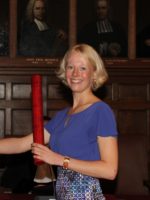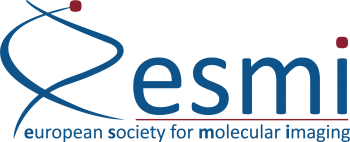Congratulations!
The PhD Award for excellent PhD thesis 2015 goes to Anoek Zomer from Utrecht for her thesis on “Intravital imaging of plasticity during tumor growth and metastasis”
Intravital imaging of plasticity during tumor growth and metastasis
Abstract
Most tumors consist of a heterogeneous mixture of genetically and epigenetically distinct tumor cells. In addition, tumors display regional differences in the tumor microenvironment comprising non-transformed cell types such as immune cells and non-cellular factors including growth factors and the extracellular matrix. As a consequence of this intra-tumor heterogeneity, individual tumor cells may differ in a variety of features such as the ability to contribute to growth and to metastasize. Complications after metastatic spread are the major cause of cancer-related deaths, but the precise contribution of intra-tumor heterogeneity to this clinical problem is still not fully understood.
To investigate the full complexity of heterogeneous tumors, until recently, most studies relied on the use of relatively large numbers of cells, for example for genome-wide sequencing or proteomics. However, the presence of rare but biologically relevant cells is difficult to resolve from these data, and thus these methods may not completely reveal the full spectrum of heterogeneity. While techniques such as histochemistry or single cell sequencing significantly contributed to a more detailed understanding of intra-tumor heterogeneity on a single cell level, these methods only provide a static view and do not assess the adaptive properties and functional role of individual cells present in living organisms. To study in vivo dynamics of single cells within heterogeneous tumors, in the studies described in this thesis we make use of fluorescent mouse models and intravital microscopy, an imaging technique by which individual cells inside a living organism can be visualized at subcellular resolution. Using these methods I 1) visualized and characterized the growth of breast tumors in living mice, and 2) studied the exchange of biomolecules through extracellular vesicles in living mice.
Impact of work
During my PhD I developed new imaging tools to 1) visualize and characterize the growth of breast tumors in living mice, and 2) study the exchange of biomolecules through extracellular vesicles in living mice.
The first project is extremely relevant in the light of anti-cancer therapies. It has been hypothesized that most anti-cancer drugs mainly target more-differentiated tumor cells whereas cancer stem cells (CSCs), cells that drive the growth of a tumor, survive these treatments. At the time I started my PhD, all evidence for the presence of CSCs in primary tumors was based upon transplantation assays which study the capacity of specific tumor cell subpopulations to reform a tumor identical to the original tumor upon transplantation in recipient mice. Since it was unknown whether this assay accurately reflects cell behavior required for the growth of an unperturbed tumor, I developed intravital lineage tracing techniques based on confetti reporter mice. Using this method I was able to demonstrate that the growth of mammary tumors is driven by a few cells with stem cell characteristics, and in addition I provided the first experimental evidence for the existence of in vivo CSC plasticity, the ability of tumor cells to acquire/activate and lose/deactivate stem cell properties. This work, published in Stem Cells, suggests that new therapeutic strategies may want to combine CSC-targeting agents to kill the tumor cell population responsible for tumor growth with agents targeting the more-differentiated cells to prevent cells from regaining CSC properties.
The second project aimed to study the exchange of extracellular vesicles (EVs) between cells under physiological conditions (in vivo). I developed a Cre-Lox system to induce a color-switch specifically in cells that take up EVs released from cells expressing the Cre recombinase (this method is described in a paper recently accepted in Nature Protocols). By combining this technique with intravital imaging I provided the first evidence for functional EV transfer in living organisms. Since the Cre-Lox method allows the detection of cells that take up EVs released by experimentally defined donor cells—i.e., the user determines which cells are used as Cre+ cells and which cells are used as reporter+ cells, this method is extremely valuable for a broad variety of research fields. This is also illustrated by the many requests we received, both for materials and starting up collaborations.
Using the Cre-Lox system and intravital microscopy, I showed that malignant tumor cells, through transfer of EVs, enhance the migratory behavior and metastatic capacity of less malignant cells. This study, published in Cell, suggests that the biology of tumor progression is even more complex than currently anticipated. For example, EV-mediated long-range intercellular communication could indicate that metastasized cells may influence the metastatic capacity of less malignant primary tumor cells or that tumor cells that have acquired resistance to chemotherapy may influence therapy resistance of other tumor cells.
Anoek’s comments on her future carreer plans
During my PhD training, I mainly focused on the interactions between different tumor cells, and the effect of this tumor-tumor cell communication on for example the ability to metastasize. However, a tumor is much more than ‘just’ tumor cells; the tumor microenvironment comprises different types of immune cells, fibroblasts, extracellular matrix, and blood and lymphatic vessels, which together influence tumor progression and therapy response. Prof. Dr. Johanna Joyce is well-renowned in the tumor microenvironment research field and as a postdoctoral researcher in her lab I am interested in understanding and targeting interactions between different cell types in the tumor microenvironment. In this way I will broaden my fundamental research knowledge obtained during my PhD, and apply this experience to more translational research. Additionally, because of my experience with two-photon microscopy and the implantation of imaging windows in mice, I’ve been asked to help setting up intravital microscopy in the new research center in Lausanne. I think this unique opportunity will also be valuable for my future career since my main aim is to build a career as an independent scientist and hopefully ultimately establish my own research group in the field of imaging and tumor biology.

Winner 2015
The committee is considering Anoek’s work as very original with high impact on in-vivo biological methods to explore cancer cells’ communication and behaviour.
“Anoek joined my lab in 2010, and she is by far the best student I have ever met. She is extremely intelligent, self-motivated and hardworking and very creative. She started to work on two challenging projects which were both high-risk, high-gain. With hard work, clever experimental design and a lot of dedication she managed to make both projects a success. I experienced first-hand how she excelled in many ways, not in the least by her perseverance in getting her work accepted in Cell, despite many, many hurdles along the way.”
Jacco van Rheenen, supervisor
